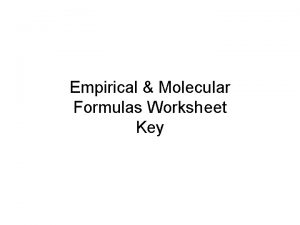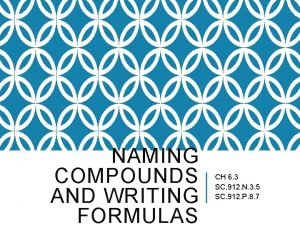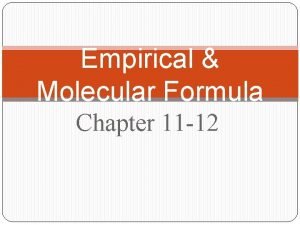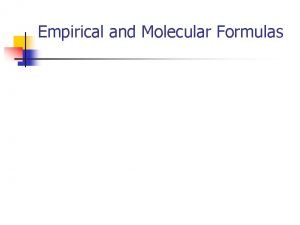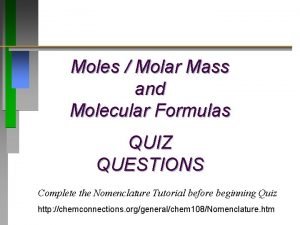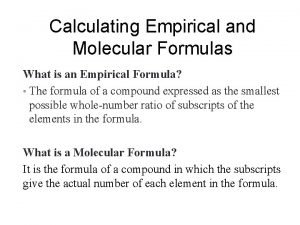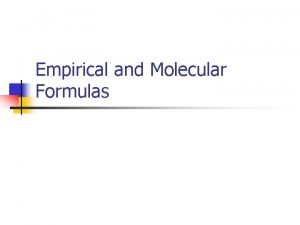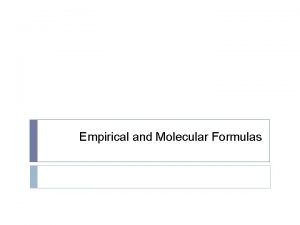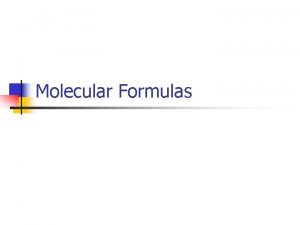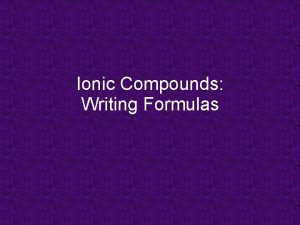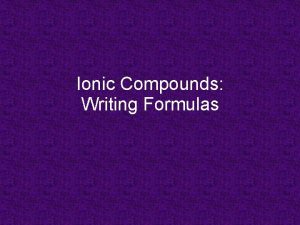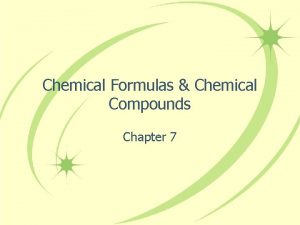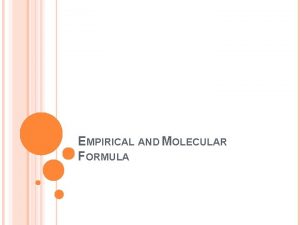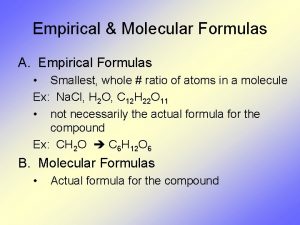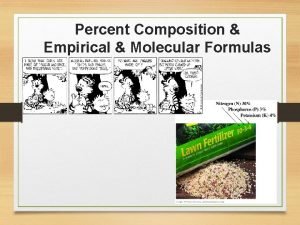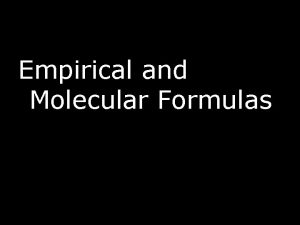Empirical and Molecular Formulas Chemical Compounds Unit Notes














- Slides: 14

Empirical and Molecular Formulas Chemical Compounds Unit Notes #5

Writing a Formula What if we wanted to be able to give a name/formula to an unknown compound, based on data? Ex. A compound weighs 298. 12 g. It is 72. 2% magnesium and 27. 8% nitrogen by mass. How could we determine its formula?

Empirical Formula A compound’s empirical formula is the smallest whole number ratio of atoms in the compound. The ratio is shown in the subscripts. Ex) NO 2 vs. N 2 O 2 It does not necessarily tell us how many atoms are in the compound.

Some Empirical Formulas Empirical Formula Actual (Molecular) Formula HO HO, H 2 O 2, H 3 O 3… CH 2 O, C 2 H 4 O 2, C 6 H 12 O 6 … CH 3 O, C 2 H 6 O 2 …

Calculating the Empirical Formula Ex. A compound weighs 298. 12 g. It is 72. 2% magnesium and 27. 8% nitrogen by mass. 1. Change the percents into masses. Mg: 72. 2% 72. 2 g N: 27. 8% 27. 8 g

Calculating the Empirical Formula 2. Find the moles of each element. Mg: 72. 2 g x 1 mole = 2. 97 moles 24. 3 g N: 27. 8 g x 1 mole = 1. 97 moles 14. 01 g

Calculating the Empirical Formula 3. Divide both numbers of moles by the smaller number. We have 2. 97 moles Mg and 1. 97 moles N Mg : 2. 97 moles / 1. 97 moles = 1. 50 N: 1. 97 moles / 1. 97 moles = 1. 00

Calculating the Empirical Formula 4. Multiply both quotients by the same number until they are both whole numbers. Mg : 1. 50 x 2 = 3. 00 N: 1. 00 x 2 = 2. 00 5. The final answers become the subscripts in the empirical formula. Mg 3 N 2

Try it! A sample is 25. 9% nitrogen and 74. 1% oxygen. 1. 2. 3. 4. 5. In grams: In moles: Divided: Multiplied: Final: 25. 9 g N; 74. 1 g O 1. 85 moles N; 4. 63 moles O N: 1. 00; O: 2. 50 N: 1. 00 x 2 = 2. 00; O: 2. 50 x 2 = 5. 00 N 2 O 5

Molecular Formula The molecular formula is the actual ratio of atoms in the compound. Many molecular formulas can have the same empirical formula. Empirical Formula Actual (Molecular) Formula HO HO, H 2 O 2, H 3 O 3… CH 2 O, C 2 H 4 O 2, C 6 H 12 O 6 … CH 3 O, C 2 H 6 O 2 …

Calculating the Molecular Formula A compound has the empirical formula CH 2 and a molecular mass of 28. 1 g/mol.

Calculating the Molecular Formula 1. Find the empirical formula CH 2 2. Find the molar mass of the empirical formula 1(12. 01) + 2(1. 01) = 14. 03 g/mol

Calculating the Molecular Formula 3. Divide the empirical mass by the molecular mass 28. 1 g/mol = 2. 00 14. 03 g/mol 4. Multiply each subscript by that quotient. CH 2 x 2. 00 = C 2 H 4

Try it! A sample is 25. 9% nitrogen and 74. 1% oxygen, and has a molecular mass of 216 g/mol. 1. Empirical formula: 2. Empirical mass: 3. Molecular mass divided by empirical mass: 4. Subscripts multiplied: N 2 O 5 108 g/mol 216 / 108 = 2 (N 2 O 5) * 2 = N 2 O 5
 Empirical formula pogil
Empirical formula pogil Modern chemistry chapter 7 review answers
Modern chemistry chapter 7 review answers Empirical and molecular formula worksheet doc
Empirical and molecular formula worksheet doc Empirical and molecular formulas worksheet
Empirical and molecular formulas worksheet Naming and writing formulas for molecular compounds
Naming and writing formulas for molecular compounds Naming compounds
Naming compounds Percentage of composition
Percentage of composition Empirical formula vs
Empirical formula vs How to turn empirical formula to molecular formula
How to turn empirical formula to molecular formula Empirical and molecular formula
Empirical and molecular formula Empirical and molecular formula quiz
Empirical and molecular formula quiz Define molecular formula
Define molecular formula Molecular formula
Molecular formula Empirical and molecular formula worksheet doc
Empirical and molecular formula worksheet doc Empirical and molecular formula worksheet doc
Empirical and molecular formula worksheet doc


